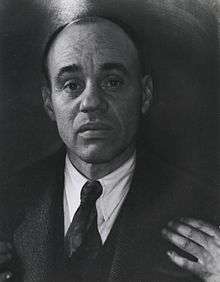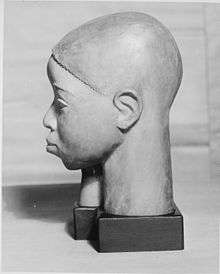Sargent Claude Johnson
| Sargent Claude Johnson | |
|---|---|
 Consuelo Kanaga, Sargent Johnson, 1934 | |
| Born |
Sargent Claude Johnson October 7, 1888 Boston, Massachusetts |
| Died |
October 10, 1967 (aged 79) San Francisco, California |
| Nationality | American |
| Known for | Painting, sculpture, ceramics |
Sargent Claude Johnson (October 7, 1888 – October 10, 1967) was one of the first African-American artists working in California to achieve a national reputation.[1] He was known for Abstract Figurative and Early Modern styles. He was a painter, potter, ceramist, printmaker, graphic artist, sculptor, and carver. He worked with a variety of media, including ceramic, clay, oil, stone, terra-cotta, watercolor, and wood.[2] He was in the Communist Party for most of his life.[1]

Early life
Sargent Johnson was the third of six children, born to a father of Swedish descent and mother of African-American and Cherokee ancestry. His father died in 1892, leaving the kids to be raised by their mother. In 1902, when his mother died, the boys of the family were sent to an orphanage in Worcester, Massachusetts and the girls to a Catholic school for African American and Native American girls in Pennsylvania. At a young age, Sargent and his siblings went to live with their uncle, Sherman Jackson Williams, and his wife, May Howard Jackson. May was a famous sculptor specializing in Negro themes, and she undoubtedly influenced Sargent Johnson at an early age. Some of his siblings did not identify themselves as African American, and chose to live as either Native Americans or Caucasians, though Sargent identified as African American.
Johnson’s transition from practicing artist to professional is largely undocumented, though some say he left from Boston to Chicago to live with some relatives. In 1915, Sargent Johnson moved to the San Francisco Bay area. The Panama-Pacific International Exposition, which had a stimulating influence on California art, took place shortly after his move. The same year, Sargent Johnson married Pearl Lawson and began studying drawing and painting at the A. W. Best School of Art. He attended the California School of Fine Arts (now the San Francisco Art Institute) from 1919 to 1923, where his teachers included the sculptors Beniamino Bufano and Ralph Stackpole.
Consuelo Kanaga, a photographer of that time, knew him well and said of Johnson, “He was beautiful in his spirit, the way he talked, the way he thought, the way he worked, the way he felt. I don’t mean he didn’t have problems. He did—terrible problems—but he was still beautiful. It was his spirit, the way he looked at everything."[3]
Career
Johnson produced witty, sophisticated work that ranges from jaunty interpretations of African masks to lithographs to small scale figures.[4]— Grace Glueck, 'The New York Times', 25 October 1996
Sargent Johnson began showing his work with the Harmon Foundation of New York in 1926. Through the foundation, known for its support of African-American art, he exhibited many of his pieces and became locally and then nationally known.[5] There was a total of 87 pieces displayed at the show and a $150 prize for most outstanding work went to Johnson, “showing a porcelain head of a Negro child, Pearl, and two drawings, one of which, Defiant, is massively constructed and as simple in its planes as is so much of the modern Mexican work."[6] He was usually not included in as “American art” because of how his pieces ignored traditional western techniques and was inspired by foreign cultures, such as Mexican muralists Diego Rivera, José Clemente Orozco, David Alfaro Siqueiros and others.
In 1928, Johnson's award winning artwork garnered him fame amongst artists in the Harlem Renaissance movement.
In the late 1930s, Sargent Johnson commissioned his work with the Federal Arts Project (FAP).[1] As a member of the bohemian San Francisco Bay community and influenced by the New Negro Movement, Sargent Johnson's early work focused on racial identity.
Johnson said, “It is the pure American Negro I am concerned with, aiming to show the natural beauty and dignity in that characteristic lip and that characteristic hair, bearing, and manner; and I wish to show that beauty not so much to the white man as to the Negro himself. Unless I can interest my race, I am sunk.”[3] According to Johnson, "Negroes are a colorful race; they call for an art as colorful as they can be made."[7]
Beginning in 1945, and continuing through 1965, Sargent Johnson made a number of trips to Oaxaca and Southern Mexico and started incorporating the people and culture, particularly archeology, into his work. Other subjects included African American figures, animals, and Native Americans.
Personal life
In 1936, Johnson and his wife separated. His only daughter, Pearl was sent to live with her mother. But in 1947, Johnson's former wife was hospitalized. In 1964, she died at Stockton State Hospital. Leading up to her death, Johnson remained on good terms with her and visited her regularly. His wife and family had a profound impact on his artwork, as most of his pieces centered around those he loved. Johnson died at his home in California from a heart attack. He had been suffering from severe angina pectoris for nearly two decades.
Auction Records
On February 23, 2010, Swann Galleries auctioned Sargent Claude Johnson’s Untitled (Standing Woman), a painted terra cotta sculpture, c. 1933-35, for $52,800 - an auction record at the time for the artist. In 2009 the University of California, Berkeley unwittingly sold a work by Johnson for $164.63, that was later valued at more than a million dollars. The 22-foot carved redwood relief panel was eventually purchased by the Huntington Library and will be displayed in its new American wing.[8]
Notes
- 1 2 3 SF MOMA Exhibition
- ↑ Ask Art
- 1 2 3 Bearden, Romare, and Harry Henderson. A History of African-American Artists From 1792 to the Present. 1st ed. N.p.: Pantheon, n.d. Print.
- ↑ Glueck, Grace. "United by the Spirit of the Protest: Connecting Mexicans and Black Americans". The New York Times, 25 October 1996. Print.
- ↑ "Rare Exhibit Displayed by Race Artists: Wide Variety Attracts National Interest." The Chicago Defender, 14 January 1928. Print.
- ↑ "Sargent Johnson Wins Chief Prize at Exhibition by Negro Artists, Sponsored by Harmon Foundation." The New York Times, February 21, 1933. Print.
- ↑ Cartage.org
- ↑ Carol Pogash, "Berkeley’s Artwork Loss Is a Museum’s Gain", New York Times, February 20, 2012.
External links
-
 Media related to Sargent Claude Johnson at Wikimedia Commons
Media related to Sargent Claude Johnson at Wikimedia Commons - Sargent Johnson in Voices and Images of California Art